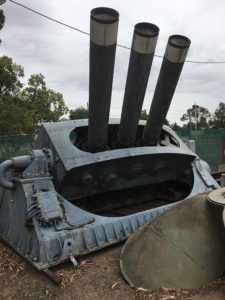- Author
- Editorial Staff
- Subjects
- Ship design and development, Naval Technology
- Tags
-
- RAN Ships
- HMAS Vampire II
- Publication
- September 2021 edition of the Naval Historical Review (all rights reserved)
In November 2020 the Naval Historical Society was approached by colleagues from across the Tasman for help in finding a Mortar Mark 10 which was required for their museum.
During the development of the anti-submarine mortar the first system known as Hedgehog was developed in 1942, this was soon replaced by the Squid with a much larger explosive charge, and the final phase of development was the Limbo, also known as the Mortar Mark 10, which extended the range of the weapon from about 300 yards (Squid) to 900 yards (Limbo).
The Squid was fitted to the first Australian post war destroyers HMA Ships Anzac and Tobruk but later vessels were fitted with the Mortar Mark 10 (MM10) which remained in service for many years. The sonar controlled three barrelled mortar (both Squid and Limbo) could automatically fire three bombs, each of 400 pounds with an explosive warhead of 207 pounds, at a submarine target. Set at various ranges and depths, if they landed in close proximity they were deadly.
In the Royal Australian Navy, the anti-submarine mortar was gradually replaced by an Australian designed guided missile known as ‘Ikara’. We now only hold two MM10s, one held for display purposes by the training establishment HMAS Watson and another spare at Spectacle Island.
The well-known, and now retired, Naval Armaments Officer Robert (Bob) Curran was consulted, and he knew of an ex-RAN anti-submarine mortar held by the Cowra War, Rail & Rural Museum, also known as the Cowra Fun Museum.
With further research we discovered that the Cowra Museum closed in 2017. The display equipment was then auctioned by Burns & Co of Mildura and the items dispersed far and wide. Listed in the catalogue held by the museum was an anti-submarine mortar ex-Tobruk. Bound by confidentially agreements, the auction house was unable to say who had purchased this equipment.
As there is a change in configuration between the systems, closer inspection reveals that the mortar held at the Cowra museum was a Limbo system whereas Tobruk had the Squid. The probable origin of the Cowra mortar is that it came from HMAS Vampire, as when she was converted to the training role in 1980 her Limbo system was removed, and quite likely ended its days at the Moorebank Stores Depot awaiting disposal.
With the trail going cold the helpful local newspaper The Cowra Guardian agreed to run an advertisement under the banner ‘The Navy Needs Your Help’ with a précis of the story. Within days this had been picked up by a sharp-eyed local resident John Davidson. John then contacted his twin brother Geoff who had left the region as a youngster many years ago to take up an apprenticeship at Garden Island Dockyard.

Geoff Davidson made his name as a weapons system engineer and served at Garden Island, on exchange in the United States, and later with the Department of Defence. Now retired in Canberra, Geoff kindly telephoned our Editor, saying he recalled in about 1998 coming across some old weapons at the Moorebank Depot destined for scrap. Thinking of a more dignified end to these historic relics Geoff contacted Ron Horsfall who ran a museum at his home town of Cowra. Ron agreed to take the mortar, at no charge but the museum paid for transportation.
So in the midst of a COVID lockdown in August 2021 this is where we are. We have tracked down a Mortar Mark 10 (most likely from HMAS Vampire) for our Kiwi cousins. However, its final resting place has for the present eluded us. Should any of our readers have any further information this would be gratefully received.




